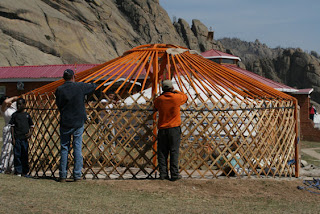While we where away in the country side we were able to help put up a ger. I have seen many gers and had wondered how they were put up so I found this process very interesting. Let me tell you a little bit about the histroy of this traditional Mongolian house.
The Mongolian Ger also known as a "yurt" is an amazing heritage of the nomadic style of life, which has been transformed into the present form and design since three thousand years. The Mongolian ger has always been an important part of the nomads' life as a dwelling and living space. In Chinggis Khan's time gers where even put up on carts and drawn by cows and camels without demolition the gers when moving.
With each season the nomadic people will move their gers to different locations for better feeding grounds for their live stock. No matter which location a ger is moved to the custom of setting the door of the ger is always facing south as it is related to the wind blowing from the north in all parts of Mongolia.
There is also a number of rules which guests should follow in a ger.
DO: Leave all weapons outside, take at least a little of any food or drink offered, if offered vodka use the ring finger to flick a small amount to the sky, wind and the earth before drinking, always move around the ger in a clockwise direction, remove gloves before shaking hands and remove your hat before entering the ger.
DO Not: Step on the threshold, touch or learn on the bagana, point your feet at the hearth, put rubbish on the fire, bring sharp objects close to the fire, sit with your back to the altar, whistle (ghosts will come), write in red pen, step over anyone, particularly older people, point a knife at anyone and sit with your feet in front either kneel or sit crossed legged.
A ger will usually take about one hour to put up and the steps are always done in the same order and when the ger is being moved then the same steps are followed backwards.
Step 1: The walls are pull out and held up so they can be tied together.

Step 2: The door is then tied to walls of the ger
Step 3: The toono is the top point of the ger, it helps keep the round shape of the ger. It is put up supported by the two props, bagana. The two props are also know as a male and female part of the ger as when you have guests in a ger the males sit on the male side and females sit on the female side.

Step 4: The wooden sticks known as the uni joins to the toono and the walls. The wooden sticks go into the sockets that surround ans support the toono. The end of the wooden stick that attaches to the wall part has a leather loop that attaches to the wall part of the ger.


Step 5: The internal cover and tsavag is place on the ger.


Step 6: The tuurga is now placed on the walls and roof which is made from felt.

Step 7: A plastic sheet is then placed over the felt to help protect from moisture. This is a modern day step that is used to help protect the ger.

Step 8: A white cotton cover is then placed over the plastic to help also protect the felt and improve the look of the ger from the outside. At this stage a light sized person climbs on top of the ger to help position this cover.

Step 9: An outer canvas cover is then placed over the cotton cover to also help for protection of the ger.

Step 10: Three ropes usually made from horse hair or modern day materials is tied around these covers to help hold the covers in place.



Step 11 the final step : The Urkh which is a square cover made of felt or canvas is placed on the top of the toono and tied down. This urke is used to let light into the ger or keep out the wind depending on the season.
A ger can be decorated in many different ways. A common way is by using paint as seen in the below pictures.


The following pictures are an example what a ger might look like in side. These pictures where of a small ger set up as a musuem at the camp we stayed out on the trip to the country side.












No comments:
Post a Comment